
Why does mold removal always turn into a weekend-long 5-minute project?
Few things can ruin wood faster than the sudden appearance of mold. It creeps in unnoticed, staining surfaces with dark spots and filling the air with a musty odor.
With the right approach, you can stop mold in its tracks and restore your wood safely.
In this guide, we’ll cover:
- The best commercial cleaners to kill deeply penetrated mold
- DIY cleaning recipes for surface-level mold
- Tips to stay safe
Let’s get started!
Things To Know Before Cleaning Mold On Wood
Tools And Supplies
Before tackling mold, having the right tools and safety gear makes the job cleaner, faster, and safer. Especially for large mold removal jobs, wearing protective gear is essential.
- N95 Mask Or Cartridge Respirator: N95 masks protect lungs from mold spores while cartridge respirators should be used when dealing with strong fumes.
- Chemical-Resistant Gloves: Shields skin from harsh cleaners and mold exposure.
- Safety Goggles: Prevents splashes or debris from irritating your eyes.
- HEPA Vacuum (Optional): Captures mold spores and dust without spreading them. Standard shop-vacs spread 70% of captured spores back into the air; HEPA vacuums retain 99.97% of particles 0.3-microns or larger.
- Plastic Sheeting or Drop Cloths: Covers nearby furniture or flooring during cleaning. Plastic sheeting is also used to isolate other areas of home from mold spores.
- Fan or Dehumidifier: Speeds up drying and helps prevent mold from returning. Mold stops growing below 60% relative humidity; keep it under 50% for 48-hrs post-cleaning to prevent regrowth.
Surface Mold vs. Deep Mold
Light mold is usually surface-level, limited to small areas, and can be wiped off. Regular household cleaners such as borax or white vinegar can be effective.
If mold has grown into the wood, it typically requires a commercial mold-removal product.
For serious infestations, commercial or contractor-grade cleaners are recommended because they contain potent biocides that kill spores deep in the wood, something household solutions often can’t achieve.
Top 4 Moisture Sources of Mold
Mold cannot grow without a moisture source. Prior to removing mold from wood, it’s a good idea to pinpoint the water leak, condensation, or poor airflow that is contributing to the mold problem. If the source of water is not removed, the mold is likely to grow again after cleaning!
Below are the top 4 sources of moisture that starts mold growth:
- Roof leaks: Water intrusion through damaged shingles, flashing, or vents.
- Plumbing leaks: Leaking pipes, fittings, or fixtures (especially inside walls or under sinks).
- Condensation: Poor ventilation, high humidity, or cold surfaces (e.g., basement walls, windows).
- Foundation or basement seepage: groundwater intrusion or poor drainage around the home.
When To Call A Professional
Certain mold infestations may require professional remediation such as:
- Large areas (over 10 square feet)
- Mold in HVAC systems
- Mold causing structural damage
These types of mold jobs typically need a professional remediation due to the higher health risks and specialized equipment. You can learn more about spotting black mold in your HVAC system here.
#1. RMR-86 and RMR-141 (Best Commercial Cleaner)

- Active Ingredients: RMR-86 uses sodium hypochlorite (bleach) with surfactants; RMR-141 uses quaternary ammonium chloride biocides.
- Coverage: RMR-86 covers ~200–400 sq ft per gallon; RMR-141 covers ~250–300 sq ft per gallon.
- Indoor Use: Both can be used indoors with proper ventilation and PPE.
- Best Use: RMR-86 removes light to moderate mold and stains, while RMR-141 is a fungicide that kills deeper mold spores.
RMR-86 and RMR-141 are two of the top mold-removal products on the market for serious infestations of wood. Both of these products were developed by Chris Atkinson in 2013 with his company RMR Solutions.
RMR-86 For Stains
RMR-86 is a mold and mildew stain remover that was specifically designed to lift stains off surfaces such as wood. It is formulated with sodium hypochlorite (bleach), surfactants, and stabilizers that quickly stops mold stains.
It’s recommended to first use RMR-86 for mold stains on the wood surface prior to using RMR-141. The mold stains usually clears up within minutes of spraying, and without brushing or scrubbing the surface.
RMR-141 For Deeper Mold
RMR-141 is designed to deeply penetrate wood in order to kill mold spores. It uses a proprietary blend of biocides and surfactants to kill mold at the roots within the wood.
The chemicals in RMR-141 seep deep into the wood, carried by capillary action through its network of tiny channels.
It’s essential not to wash off the RMR-141 but to let it air dry naturally or to use a blower fan — it should not leave a residue.
Possible Hazards
I strongly recommend wearing PPE such as a cartridge respirator, gloves, goggles, and hazmat suit — especially for spraying larger areas. Otherwise, ventilate the area well, don’t breath in the fumes, and don’t let it get on your skin or clothes.
There is a possibility of lightening wood which can be an issue for furniture. If it comes into contact with metal (or even just the nearby vapor), it can corrode nails, brackets, etc.
RMR-141 may also weaken wood integrity if it’s used too much and if it’s used repeatedly.
For areas like basements where mold can penetrate deep into wood and drywall, additional steps may be required, check out our full guide to removing black mold in basements here.
5 Steps To Using RMR-86 and RMR-141
- Safety Prep: Ventilate area; wear PPE (cartridge respirator, hazmat suit, gloves, goggles). Cover surroundings; test both products on hidden wood spot (wait 10 min, check damage).
- Surface Prep: Vacuum loose mold; ensure wood is dry.
- Apply RMR-86: Spray liberally to saturate pores; let dwell 10-15 min to lift deep stains. Wipe with damp cloth; rinse if needed, dry fully with fans.
- Apply RMR-141: Spray generously on cleaned area; ensure 10-min contact to kill embedded spores. No rinse — let air dry completely (24+ hrs).
- Inspect & Finish: Check for residue/mold; repeat if needed. Address moisture source; seal wood with mold-resistant primer.
#2. White Vinegar (Best Household DIY)
- Active Ingredient: Acetic acid (typically 5% for household vinegar).
- Coverage: Depends on surface size; best for small areas.
- Indoor Use: Yes, safe for indoor use; strong odor may linger temporarily.
- Best Use: Surface-level or light mold on wood, furniture, and other household items; also helps deodorize musty smells.
White vinegar is a widely used natural cleaner that can be used to remove mold from wood or furniture. Vinegar contains up to 5% acetic acid which damages mold cell membranes and their proteins.
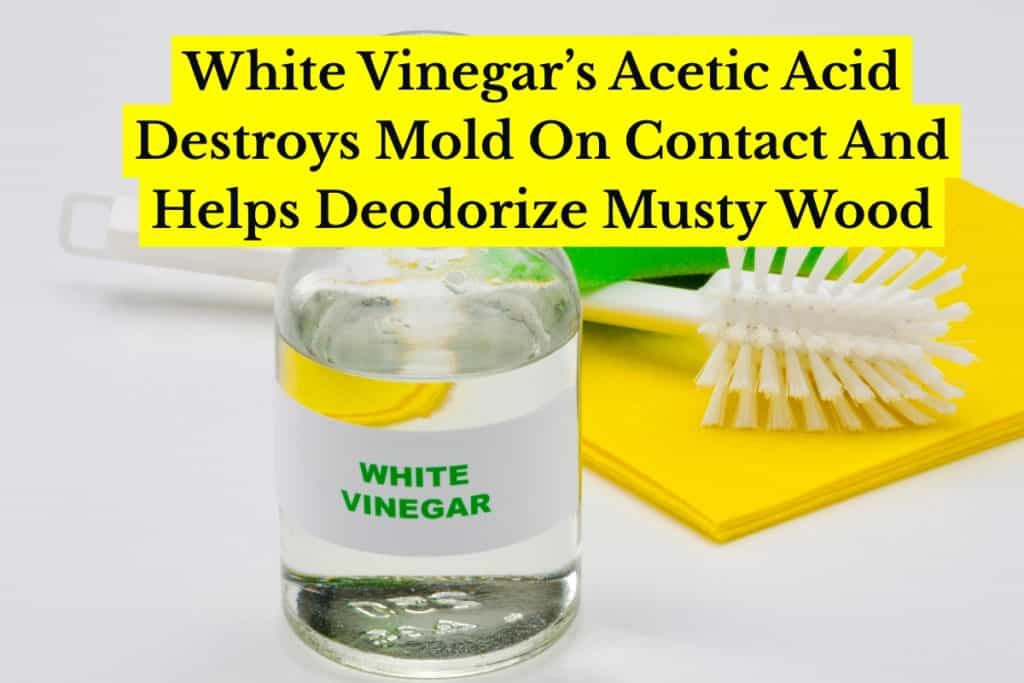
Its best application is for surface-level or light mold and should be used without dilution or water for better results.
The top benefit of white vinegar is that it’s non-toxic, cheap, and most homes already have it. White vinegar can be safely used in homes with children and pets, and it will deodorize musty smells.
Probably the biggest negative of using vinegar for mold is the strong smell which can linger after the cleaning job. There is also a possibility of changing the color of wood that is darkly stained, so be careful and test it first. White vinegar is unlikely to have any effect on mold that has grown into the wood.
6 Steps To Using White Vinegar
- Clean Surface: Wipe away dust and loose mold with a dry cloth or soft brush.
- Apply Vinegar: Pour undiluted white vinegar (5% acetic acid) into a spray bottle and saturate the affected wood area.
- Let It Sit: Allow the vinegar to rest for at least 1 hour so the acid can break down mold cells.
- Scrub Gently: Use a soft-bristle brush or sponge to loosen and lift mold from the surface.
- Wipe Clean: Use a damp cloth to remove residue and any remaining spores.
- Dry Completely: Air-dry or use a fan; moisture left behind can cause regrowth.
#3. Mold Control by Concrobium (Best For Indoor Use)
- Active Ingredient: Blend of sodium carbonate and surfactants (non-toxic, odorless formula).
- Coverage: ~250–300 sq ft per gallon, depending on application.
- Indoor Use: Yes, safe for indoor use with ventilation recommended.
- Best Use: Surface and moderately deep mold on wood, furniture, and other indoor surfaces.
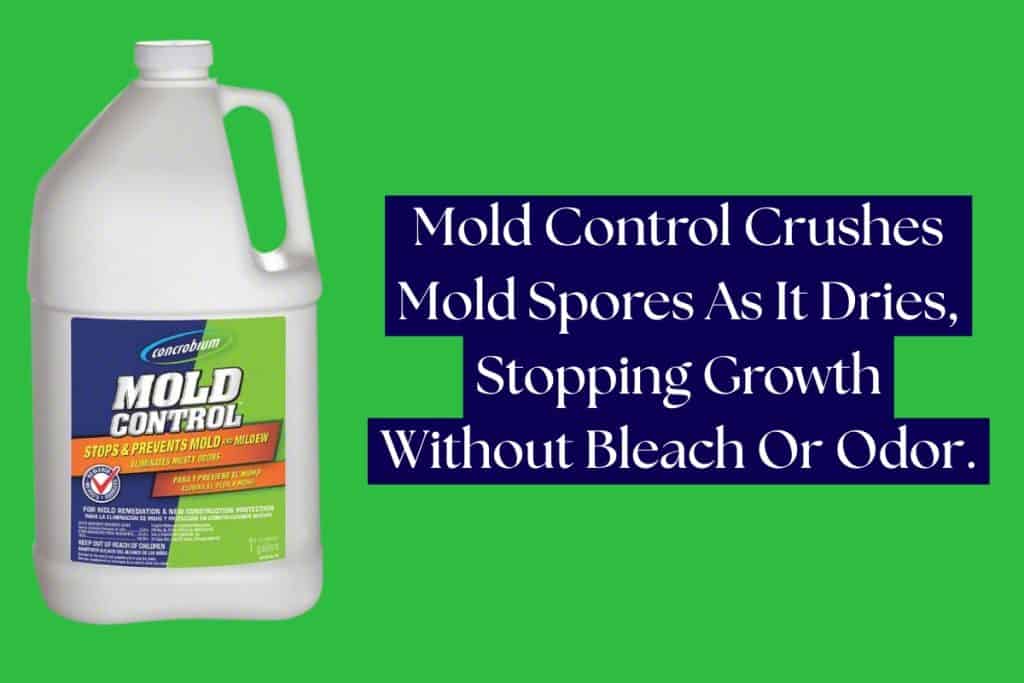
Mold Control is a popular EPA-registered cleaning spray that can penetrate mold growth in wood. It’s odorless, non-corrosive, and can be used indoors.
The main ingredient of Mold Control is sodium carbonate (and surfactants) that gets absorbed and spread into wood.
How It Works
Unlike other commercial cleaners, Mold Control relies on mechanical action to kill mold rather than chemicals.
When it’s left to dry on wood, the liquid crushes and dehydrates mold spores — destroying their cellular structure. The dried substance that remains prevents new mold spores from taking root and growing.
Even though Mold Control has a low toxicity, be careful not to inhale the mist, or get it on your skin or eyes.
Mold Control can be used indoors since it doesn’t use harsh chemicals, but ventilating the area is still recommended.
6 Steps To Using Mold Control
- Clean surface – Wipe off loose mold, dirt, or debris first.
- Apply evenly – Spray or mist Concrobium directly onto the affected wood until damp, not soaked.
- Let dry completely – Do not wipe while wet; the drying action kills mold.
- Scrub (if needed) – Once dry, scrub off remaining residue or staining with a soft brush.
- Reapply – Spray a light coat again to leave a protective barrier against regrowth.
- Allow to cure – Let the area dry thoroughly before sealing, painting, or refinishing.
#4. Borax (Best Eco-Friendly)
- Active Ingredient: Sodium borate (natural mineral with alkalinity of ~9.3-pH).
- Coverage: About 200–300 sq ft per gallon of solution.
- Indoor Use: Yes, safe for indoor cleaning with minimal fumes.
- Best Use: Light mold growth on unfinished or raw wood surfaces.
Borax is a natural mineral (sodium borate), which has been used for various cleaning purposes for over 100 years. You may have seen a box of the stuff in your cleaning aisle at the grocery store.
Since it has a moderately high pH of 9.3, the alkalinity naturally inhibits mold and helps prevent regrowth.
The basic strategy is to dissolve Borax with water and spray or scrub it on the mold-infected wood. It’s best to leave the Borax on the wood, since the film left behind kills mold and inhibits future growth.

Borax is environmentally friendly with a low toxicity (no fumes), and it is non-flammable.
However, make sure not to inhale or get Borax in your eyes so wear protection.
Borax is ideal for lightly infested wood and is unlikely to be effective for more serious mold growths. Also, if you use too much Borax in the solution, it may leave behind a white residue.
7 Steps To Using Borax
- Mix solution – Dissolve 1 cup of borax in 1 gallon of warm water.
- Apply to wood – Use a sponge, cloth, or soft brush to coat mold-affected areas evenly.
- Scrub lightly – Gently scrub to lift mold without damaging the wood surface.
- Wipe excess – Remove leftover solution with a clean damp cloth.
- Dry thoroughly – Let the wood air-dry completely to prevent regrowth.
- Repeat if needed – For persistent mold, reapply and scrub again.
- Optional sealing – After drying, seal or refinish wood for long-term protection.
#5. MMR Mold & Mildew Stain Remover (Top Surface Cleaner)

- Active Ingredient: Sodium hypochlorite (bleach) with surfactants.
- Coverage: ~175–250 sq ft per gallon.
- Indoor Use: Yes, but requires good ventilation and PPE due to strong fumes.
- Best Use: Surface mold on wood in crawlspaces, attics, and other indoor areas; effective for light to moderate infestations.
MMR is a professional-grade mold remover that can quickly kill mold and mildew on wood.
How It Works
You don’t have to sand or scrub mold with MMR — just spray, wait a few minutes, then wipe or rinse.
MMR’s main active ingredient is sodium hypochlorite (a type of bleach), and a mixture of surfactants. These chemicals penetrate the surface and break down the mold’s mycelium rooted in the wood or material.
Possible Risks
The main drawback is that MMR has strong chemical fumes so good ventilation and a cartridge respirator is recommended. The liquid is also a skin irritant so gloves, hazmat suit, and goggles are necessary.
MMR’s corrosive nature can damage metals so avoid spraying any nails/brackets or ductwork. And be careful if using this with furniture, especially cedar and finished wood. Always test it in an inconspicuous spot first.
6 Steps To Using MMR
- Clean Surface: Remove loose dirt, debris, or dust before applying.
- Apply MMR: Spray directly onto mold-stained wood until evenly wet; avoid oversaturation.
- Wait: Let it sit for 10–15 minutes; the oxidizing action will lift and dissolve stains.
- Lightly Agitate (Optional): For heavy mold, scrub gently with a soft brush.
- Rinse or Wipe: Remove residue with clean water or a damp cloth.
- Dry Completely: Allow wood to air-dry to prevent new mold growth.
#6. Hydrogen Peroxide (Best For Light Mold)
- Active Ingredient: Hydrogen peroxide (typically 3% solution for household use).
- Coverage: Varies by surface size; generally suitable for small to medium mold patches.
- Indoor Use: Yes, safe for indoor use with ventilation.
- Best Use: Surface-level mold on wood, furniture, and other household items; can lighten stains while killing mold.
Hydrogen peroxide is a household supply that can kill mold on furniture and other wood products.
It works by releasing oxygen molecules that target the cell walls of mold spores — destroying them on contact.
Hydrogen peroxide can penetrate wood more deeply than bleach, and it can lighten any dark staining due to mold.

Since it breaks down into water and oxygen, there is no residue left behind to worry about.
The main downside of hydrogen peroxide is that it may change the wood color if it’s finished. It’s also far less effective than commercial mold cleaners and probably won’t penetrate deeply rooted mold.
6 Steps To Using Hydrogen Peroxide
- Clean Surface: Wipe off dust or loose mold with a damp cloth.
- Apply Peroxide: Pour 3% hydrogen peroxide into a spray bottle and saturate the affected wood.
- Let It Sit: Allow it to bubble and react for 10–15 minutes to kill spores.
- Scrub Gently: Use a soft brush or sponge to remove loosened mold and stains.
- Wipe Clean: Use a damp cloth to remove residue and remaining peroxide.
- Dry Thoroughly: Let the area air-dry completely to prevent new mold growth.
#7. Mold Armor – Rapid Clean Remediation (Top All-Around)
- Active Ingredient: Combination of oxidizing agents and other compounds (non-bleach formula).
- Coverage: ~250–300 sq ft per gallon, depending on application.
- Indoor Use: Yes, safe for indoor use with good ventilation.
- Best Use: Surface mold on wood, furniture, and other hard surfaces; effective for light to moderate infestations, typically without scrubbing.
Mold Armor is a commercial spray designed to kill mold — but also works on mildew, bacteria and viruses — and doesn’t use any kind of bleach.
While it’s targeted for hard surfaces, many people use it for wood surfaces with good results. You can see visible results from the spray within a few minutes, no scrubbing is usually required.
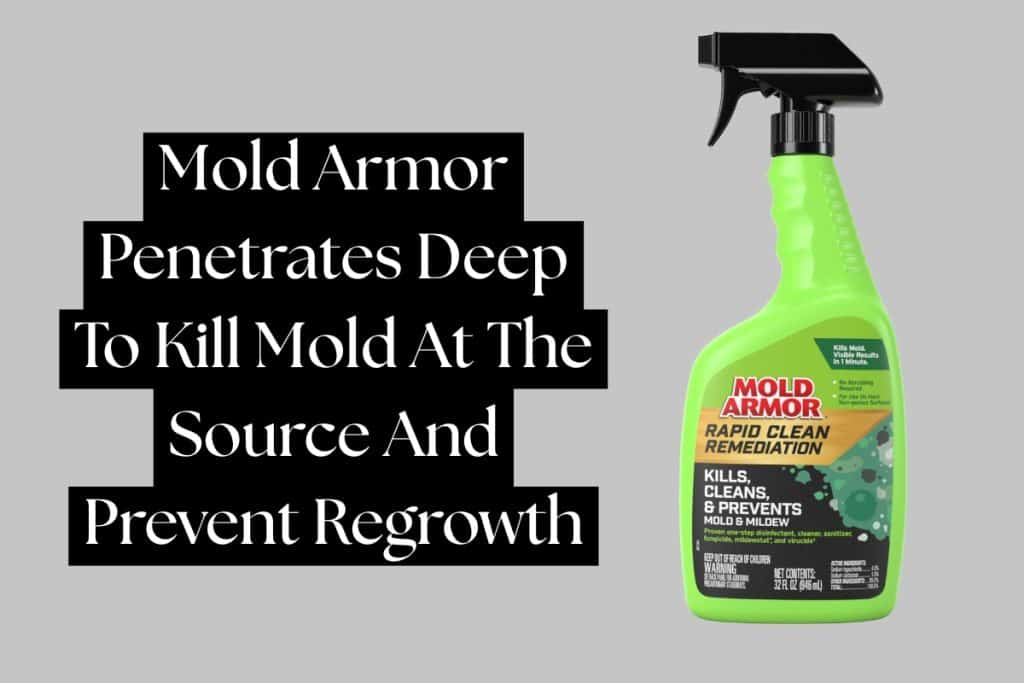
Mold Armor uses a combination of oxidizing agents and other compounds to destroy mold cell walls and kills spores on contact.
Just be careful with unfinished wood, since it may cause a color change such as with furniture. And as with most mold cleaning products, do not mix it with other cleaners such as ammonia, since it can give off toxic fumes.
7 Steps To Using Mold Armor
- Test a Hidden Spot: Apply on a small, inconspicuous area of the wood to check for discoloration or finish damage.
- Clean Surface: Remove dust or loose debris from the wood with a dry cloth or soft brush.
- Apply Product: Spray Mold Armor directly onto the moldy area until the surface is thoroughly wet.
- Wait: Let it sit for 5–10 minutes to allow disinfecting and stain removal action to occur.
- Scrub Lightly (Optional): For visible mold or stains, use a soft brush or sponge to gently agitate the surface.
- Wipe or Rinse: Remove residue with a damp cloth or clean water, depending on surface type and product instructions.
- Dry Thoroughly: Allow the wood to dry completely to prevent new mold growth.
#8. Baking Soda (Best For Odors)
- Active Ingredient: Sodium bicarbonate.
- Coverage: Depends on surface size; best for small to medium areas.
- Indoor Use: Yes, safe for indoor use around children and pets.
- Best Use: Surface-level or light mold on wood and furniture; also helps neutralize odors and prevent regrowth.
Baking soda is a non-toxic cleaning solution that can be effective for removing very light or surface mold from finished (and unfinished) wood.
How It Works
It works by raising the pH of the surface, creating an alkaline environment that disrupts mold’s ability to grow and reproduce.
Baking soda is also slightly abrasive which helps to mechanically lift off mold from the wood. The slight residue left behind on the wood can help prevent mold regrowth.
The main advantage of baking soda is that it’s a mild cleaner, and safe to use around pets and kids. It’s effective for light mold growth and it will deodorize the wood of musty smells at the same time.
Baking soda is an all-around gentle product so it shouldn’t affect the color or finish of wood, though I recommend testing it in a small area first.
The downside of baking soda is that it won’t penetrate wood for deeply embedded mold. It may also leave behind a powdery white film which may need to be rinsed off.
6 Steps To Using Baking Soda
- Mix Solution: Combine 1 tablespoon of baking soda with 1 cup of warm water in a spray bottle or bowl.
- Apply to Surface: Spray or dab the mixture directly onto the moldy wood area.
- Let It Sit: Allow the solution to rest for 10–15 minutes to loosen mold and neutralize spores.
- Scrub Gently: Use a soft brush or sponge to lift mold without damaging the wood grain.
- Wipe Clean: Remove residue with a damp cloth.
- Rinse (Optional): For visible residue, rinse with clean water and wipe again.
#9. ZEP Mold and Mildew Cleaner (Best Budget)
- Active Ingredient: Sodium hypochlorite (bleach) and surfactants.
- Coverage: Varies by surface size; generally suitable for small to medium areas.
- Indoor Use: Yes, with proper ventilation and PPE; avoid mixing with other cleaners.
- Best Use: Surface-level mold and mildew on wood, treated or untreated; effective for quick stain removal without extensive scrubbing.
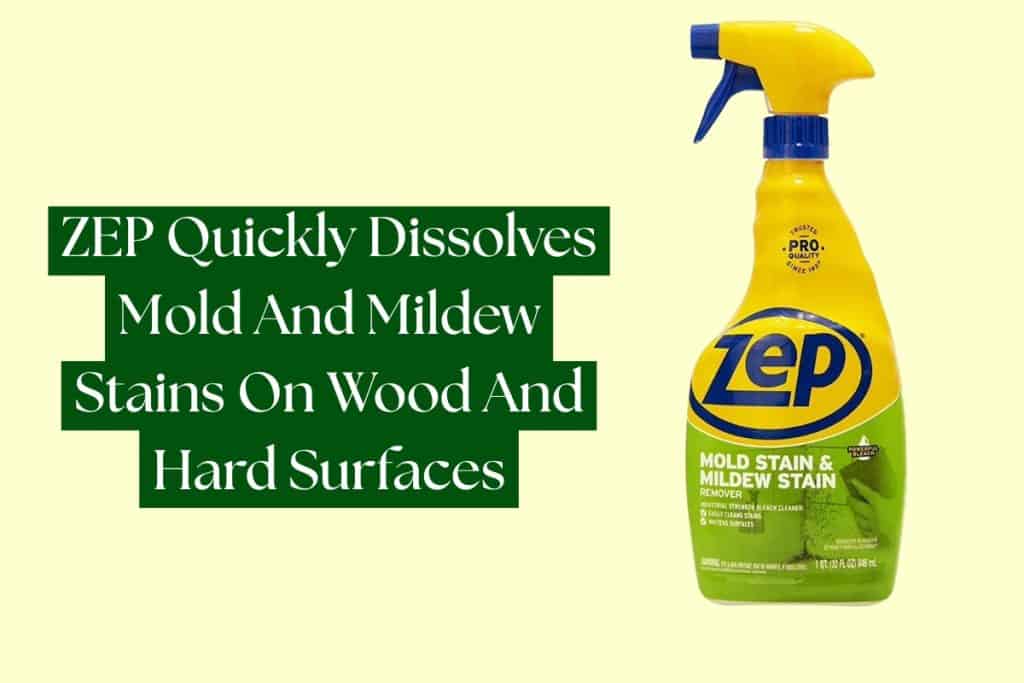
ZEP Mold Stain & Mildew Stain Remover is a bleach-based spray that quickly dissolves mold stains on surfaces, including wood.
The bleach (sodium hypochlorite) and similar ingredients have a strong oxidizing effect that can destroy mold cells and lighten dark stains.
This powerful mold cleaner doesn’t require scrubbing; you spray it on, wait one minute, and rinse. You can use it indoors or outdoors and on treated/untreated wood.
ZEP contains bleach so it does have a strong smell, ventilating the area is recommended.
As with all other cleaners, if you use it on furniture, test it first on an inconspicuous spot just in case it changes the color — especially if it’s already stained. Be careful not to mix this spray with any other cleaning product (such as ammonia) since it can react with the bleach and give off toxic gases.
7 Steps To Using ZEP
- Protect Nearby Materials: Ensure good ventilation and cover nearby surfaces, fabrics, or metals to protect from bleach damage.
- Test a Hidden Spot: Apply a small amount on an inconspicuous area to check for wood discoloration or finish damage.
- Clean Surface: Remove loose dust or debris from the wood with a dry cloth or brush.
- Apply Product: Spray ZEP Mold & Mildew Stain Remover directly onto the moldy area until evenly damp.
- Wait: Allow it to sit for at least 1-minute so the bleach-based formula can oxidize and lift stains.
- Scrub Gently: Use a soft brush or sponge to agitate the surface if needed.
- Rinse or Wipe Clean: Use clean water or a damp cloth to remove residue.
#10. Sanding (Best Mechanical)
- Coverage: Depends on mold area; best for small sections or spot treatment.
- Indoor Use: Yes, but ideally done outdoors or in a well-ventilated area to avoid inhaling spores.
- Best Use: Light to moderate mold that remains after cleaning; effective for surface stains or shallow mold in furniture and unfinished wood.
Sanding is a reliable and mechanical way to remove mold from wood especially for stains after cleaning.
It’s a good technique for light mold infestations and for small areas such as on furniture.
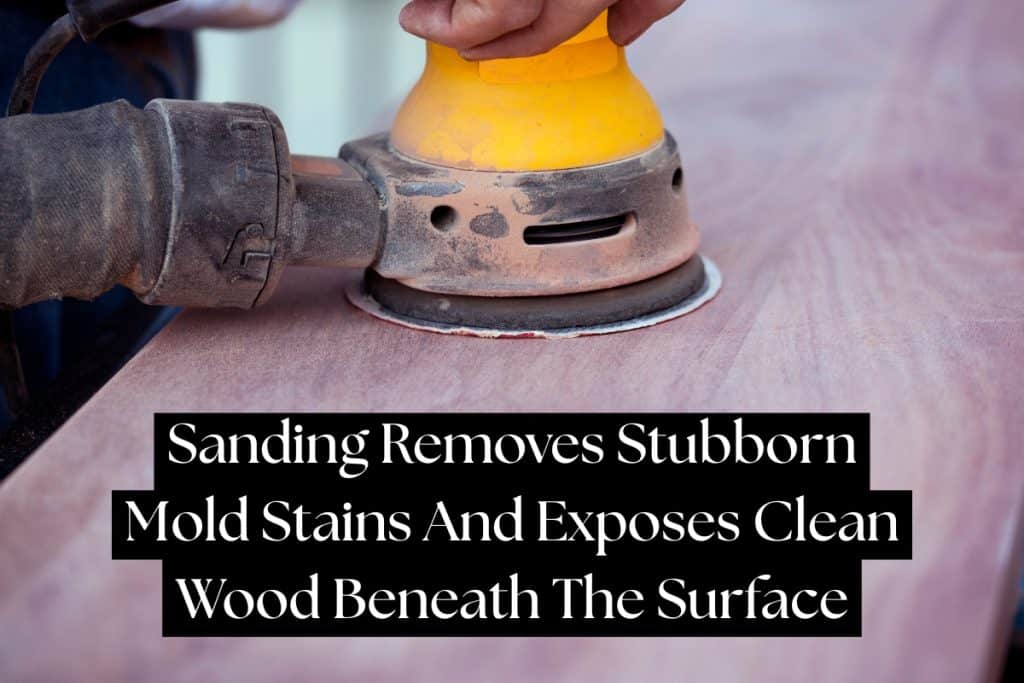
Sanding strips the wood of any embedded or surface mold to get to clean wood underneath.
The first step is to clean and thoroughly dry the wood to help reduce the mold spores that go into the air during sanding. It’s best to sand the wood outside if at all possible and to wear a respirator to avoid breathing in dust.
I recommend using medium to fine grit sandpaper and moving to fine grit at the end.
I don’t recommend using this method on finished or sealed wood or furniture unless you are okay with refinishing.
7 Steps To Sanding
- Inspect the Wood: Confirm mold has penetrated beyond the surface.
- Clean First: Wipe with vinegar or mild cleaner to remove loose mold and let it dry completely.
- Protect Yourself: Wear an N95 respirator, gloves, and eye protection. It’s best to sand outdoors or in a well-ventilated area to avoid inhaling spores.
- Sand The Surface: Use 120–220 grit sandpaper; move with the grain until stains are gone.
- Vacuum or Wipe Dust: Use a damp cloth or HEPA vacuum to remove debris.
- Disinfect Again: Lightly mist the area with vinegar or borax solution to kill lingering spores.
- Dry Thoroughly and Seal: Ensure no moisture remains before refinishing. Apply a wood sealer, varnish, or paint to block future mold growth.
Final Thoughts
Removing mold from wood doesn’t have to be overwhelming. With the right tools, techniques, and a bit of patience, you can restore your wood’s natural beauty and stop mold from coming back.
Whether you choose DIY methods like vinegar or borax, or stronger commercial treatments for deeper infestations, consistency and thorough drying are key.
I hope you enjoyed this guide by BirchSill, leave me a question below or share your experience with removing mold off of wood!

